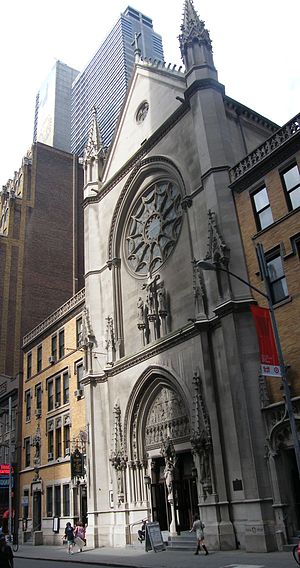- Napoleon LeBrun
-
Napoleon LeBrun 
Episcopal Church of Saint Mary the Virgin on West 46th Street, off Times Square; Photographed 2008Born January 2, 1821 Died New York City, New York Nationality USA Other names July 9, 1901 Known for Architect Napoleon Eugene Charles Henry LeBrun (January 2, 1821 – July 9, 1901) was an American architect. LeBrun is best known as the architect of several notable Philadelphia churches, including St. Patrick's Catholic Church, Twentieth Street (1841); the Seventh Presbyterian Church (1842), the Scots Presbyterian Church (1843), the Church of St. Peter the Apostle (German Catholic), Fifth Street (1843); the Protestant Episcopal Church of the Holy Nativity (1844), no longer standing; St. Augustine's Church, Fourth Street [1]; and the Cathedral-Basilica of SS. Peter & Paul, Logan Square. He also designed the American Academy of Music at Broad and Locust Streets.
He was a prominent architect in Pennsylvania. He designed the Schuylkill County Prison in Pottsville, a site that later gained historical significance as the site of several hangings of "Molly Maguires," a rebellious secret society that operated in the coal fields during the 1860-1970s. [2] He also designed the first Columbia County Courthouse in Bloomsburg and the 1854 Montgomery County Courthouse in Norristown , Pennsylvania. Although both were later extensively redesigned and expanded, the notable and distinguishing marble facade of the Montgomery County Courthouse remains his outward and identifying creation.
Sometime after 1861, LeBrun relocated his family to New York City, where his sons Pierre L. and Michel Moracin would join him in a firm that would become N. LeBrun & Sons, the official architects of the New York City Fire Department in the latter half of the 19th century. N. LeBrun and Sons were also instrumental in designing some of the earliest skyscrapers, including the Metropolitan Life Insurance Company Tower. In New York, the LeBrun firm also designed several notable churches, including the Roman Catholic Church of St. John on West 31st Street, staffed by the Capuchins, and the Episcopal Church of Saint Mary the Virgin on West 46th Street, off Times Square. Saint Mary's had, and has, a steel superstructure and was, for that reason, among its other sobriquets (Smoky Mary's), known in its early days as the "Chicago Church."
LeBrun was a son of the Napoleonic ambassador to the United States who, after the denouement of that regime, remained in this country and settled in Philadelphia. LeBrun's early architectural training was in the offices of Thomas U. Walter in Philadelphia, later to become architect of the United States Capitol. LeBrun, as a young man in his twenties, found opportunity in the booming industrial development of the Schuylkill Valley in the 1840s. That accounts for his commission for the Montgomery County Courthouse in Norristown. His other early work includes the original version of Trinity Episcopal Church, Pottsville (1847), still standing though much altered by later revisions, which replaced an 1827 structure by William Strickland. His commission for the church, memorialized in the minutes of the Trinity vestry of the time as a payment to "N. LeBrun, architect" was probably the springboard for his commission for the Schuylkill County prison (1851), upon the relocation of the county seat from Orwigsburg to Pottsville. There is probably other early work of LeBrun in the Schuylkill Valley that remains to be discovered and recognized.
See also
- Firehouse, Engine Company 31
References
External links
Categories:- 1821 births
- 1901 deaths
- American architects
- American people of French descent
- Defunct architecture firms based in New York City
- American ecclesiastical architects
- Architecture firms based in Pennsylvania
- Architects of Roman Catholic churches
- Architects of cathedrals
Wikimedia Foundation. 2010.
